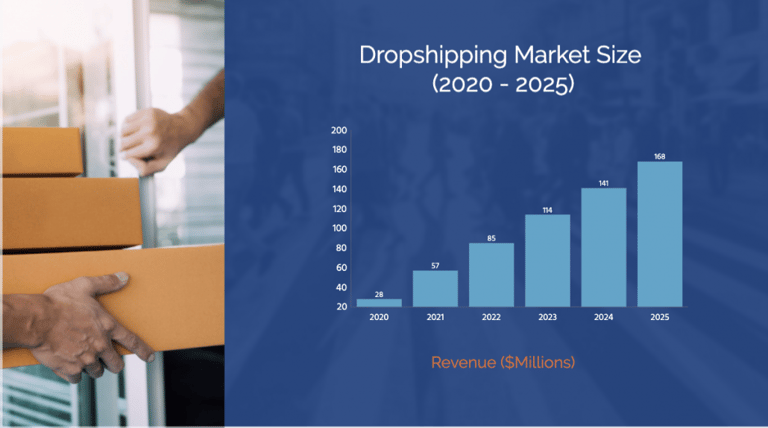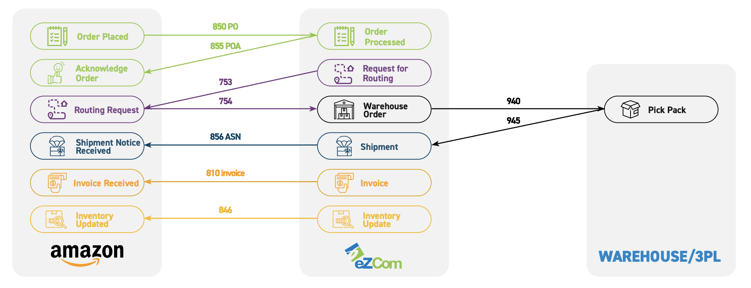Drop shipping and online sales remain a bright spot in retail, and the opportunities they present for brands and suppliers can’t be ignored. According to a report from the National Retail Federation (NRF), non-store—outside of brick-and-mortar locations—and online retail sales are expected to grow between 11% and 13% in 2022. That translates to a market size of $1.17 trillion to $1.19 trillion. Clearly, online warrants serious focus, and major retailers now expect companies to drop ship direct-to-consumer. The challenge is that it’s an entirely different sort of order processing, requiring small shipments to hundreds of addresses instead of large shipments to a single store or distribution center. So the question is: how can you make drop shipping easier?
Why drop ship at all?
Yes, drop shipping for retailers can be a challenge. But there’s no question it’s a trend that will continue—roughly 27% of online retailers have adopted some kind of drop shipping program. Most come with specific requirements for compliance, including branded packing slips and shipping labels, ship-by times, and more.
Drop shipping comes with complexity, and there are myriad pain points as companies pivot to more direct-to-consumer fulfillment. But the opportunities outstrip the challenges, and brands that execute a successful drop shipping strategy will continue to grow.
Let’s talk about the issues drop shipping presents, and how we can help resolve them.

Drop shipping isn’t cheap.
You don’t need a degree in Economics to know that shipping to small orders to multiple addresses results in higher costs than sending a large order to a single warehouse or distribution center.
Online order processing requires spending more time and resources to complete fulfillment. Time is money, and if your process for drop shipping relies on manual entry instead of automation, things are going to get expensive. Quickly.
What’s more, many retailers expect the supplier to pay the cost of direct-to-consumer fulfillment. If the process isn’t managed efficiently, a company will see more revenue from online sales but sharply lower profit margins.
The solution? Automate the process and work with partners that can make your workflow as seamless as possible and solve the biggest challenges.
Drop shipping puts more pressure on suppliers.
Along with figuring out added costs, suppliers need to manage new demands from their retail trading partners. Any retailer with significant online traffic—that’s virtually all of the majors—is an opportunity and a challenge.
Simply put, retailers have the upper hand. Just as in traditional EDI, they will have standards for compliance. They’ll determine what information is needed, the sequence of events, the frequency of transmissions, and how order data is exchanged. And also just like with traditional EDI transactions, each retailer will have different rules.
That all translates into increased complexity, and increases the need for a partner that can help you manage it all. Our Lingo software is built to adapt to ever-changing compliance requirements, whether it’s for EDI, drop shipping an item purchased on a retailer web site, or managing orders from a major online marketplace. Our Set Up Team will ensure that you start the relationship on solid footing, and the experts on our Customer Support team are known for their ability to resolve issues quickly.
Drop shipping is a different animal.
While there are internet-only sellers, most brands have built their order processing and logistics around the wholesale process—large shipments sent to a limited number of addresses. Without losing focus on the traditional, profit-generating model, suppliers now need to add drop shipping to their formula.
Selling a single item that needs to be shipped direct-to-consumer is patently different. And consumers, we might add, are accustomed to prompt delivery of virtually anything they order. Patience is in short supply, and retail trading partners are trusting their suppliers to represent their brand well. When that doesn’t happen, a productive trading partner relationship is at risk.
Fortunately, the pivot doesn’t have to be difficult. If you have relied on a traditional wholesale model with EDI, it’s easier to fold drop shipping into that system than to create a different process just for online sales. If your current EDI provider can’t provide solutions to help adapt, adjust and improve your approach with features like direct connections to shipping providers, it may be time to consider a different partner. Think of order processing as a key part of your business, with drop shipping an important piece within it. And make sure you work with a software provider that can adapt to handle it all.
Make sure your order processing partner knows drop shipping. And EDI. And integrations. And…

Working with a partner that makes drop shipping seamless and efficient is critical in today’s retail landscape. After all, if you invest in making sales, you need to deliver your products in a way that satisfies today’s consumers, and keeps your trading partner relationships productive.
With our Lingo software, you can process drop ship orders using the same process that you do for wholesale EDI transactions. Instead of toggling between platforms, Lingo can handle all of it, and it can be fully integrated into the system that powers your business. It’s a powerful tool for direct-to-consumer orders, and it scales as you grow and move into more sales channels.
Our developers are always working to adapt our Lingo platform to the ever-changing retail landscape. As the drop ship category has grown, we have made it simple for our customers to process these orders in a way that eliminates pain points like increased costs, high compliance standards, and shipping. Simplicity is everything—our software and our people work hard to deliver it.






